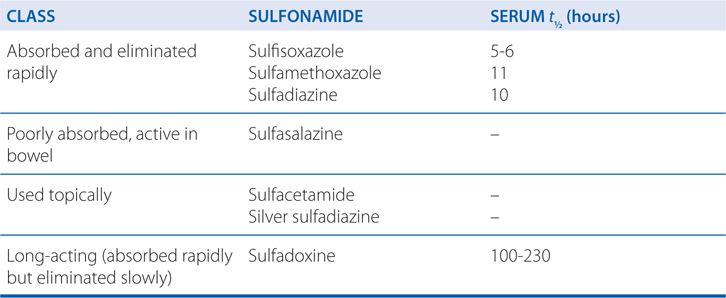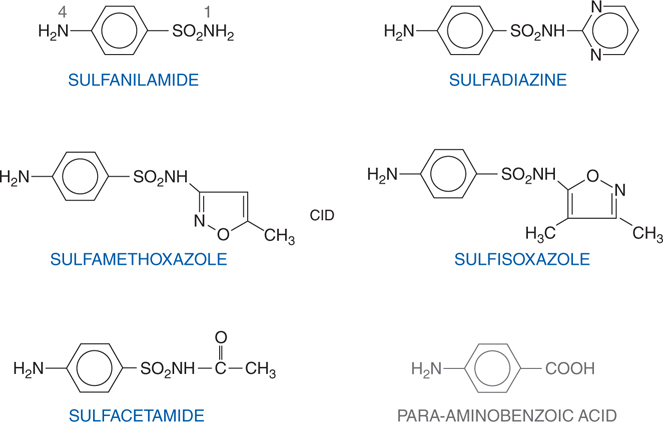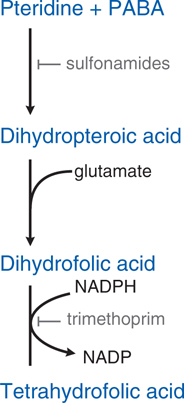38
Sulfonamides, Trimethoprim-Sulfamethoxazole, Quinolones, and Agents for Urinary Tract Infections
This chapter will be most useful after having a basic understanding of the material in Chapter 52, Sulfonamides, Trimethoprim-Sulfamethoxazole, Quinolones, and Agents for Urinary Tract Infections in Goodman & Gilman’s The Pharmacological Basis of Therapeutics, 12th Edition. In addition to the material presented here, the 12th Edition contains:
• Structural formulas for each of the drugs in this chapter, in addition to the figures reproduced here
• Table 52-2 which is a compilation of the structural formulas for selected quinolones and fluoroquinolones
LEARNING OBJECTIVES
 Understand the mechanism of action of sulfonamide drugs.
Understand the mechanism of action of sulfonamide drugs.
 Identify the various sulfonamide drugs and categorize them according to their absorption from the gastrointestinal (GI) tract.
Identify the various sulfonamide drugs and categorize them according to their absorption from the gastrointestinal (GI) tract.
 Identify the therapeutic uses and untoward effects of sulfonamide drugs including trimethoprim-sulfamethoxazole.
Identify the therapeutic uses and untoward effects of sulfonamide drugs including trimethoprim-sulfamethoxazole.
 Describe the therapeutic uses, mechanisms of action, and toxicities of quinolone antibiotic drugs.
Describe the therapeutic uses, mechanisms of action, and toxicities of quinolone antibiotic drugs.
 Identify the uses and limitations of antiseptic and analgesic drugs for the treatment of urinary tract infections.
Identify the uses and limitations of antiseptic and analgesic drugs for the treatment of urinary tract infections.
The mechanism of action of sulfonamides is shown in Figure 38-2 and the resistance to sulfonamides is described in the side bar BACTERIAL RESISTANCE TO SULFONAMIDES
The mechanism of action of quinolines is shown in Figure 38-3 and the resistance to quinolines is described in the side bar BACTERIAL RESISTANCE TO QUINOLINES.
DRUGS INCLUDED IN THIS CHAPTER
Mafenide (SULFAMYLON) Methenamine
Nitrofurantoin (FURADANTIN, MICROBID, others)
Phenazopyridine (PYRIDIUM, others)
Quinolones (norfloxacin [NOROXIN, others], ofloxacin, [FLOXIN, others], ciprofloxacin [CIPRO, others], moxifloxacin [AVELOX])
Silver sulfadiazine (SILVADENE, others)
Sulfacetamide
Sulfadiazine
Sulfadoxine (FANSIDAR)
Sulfamethoxazole
Sulfasalazine (AZULFADINE, others)
Sulfisoxazole
Trimethoprim-sulfamethoxazole (BACTRIM, SEPTRA, others)
BACTERIAL RESISTANCE TO SULFONAMIDES
Resistance to sulfonamides is the consequence of altered enzymatic constitution of the bacterial cell characterized by:
• A lower affinity of dihydropteroate synthesis enzymes.
• Decreased bacterial permeability or active efflux of the drug.
• An alternative metabolic pathway for synthesis of an essential metabolite.
• Increased production of an essential metabolite or drug antagonist.
BACTERIAL RESISTANCE TO QUINOLINES
Resistance to quinolines may develop during therapy via mutations in the bacterial chromosomal genes encoding DNA gyrase or topoisomerase IV (see Figure 38-3), or by active transport of the drug out of the bacteria.
A 56-year-old woman presents with symptoms of her second urinary tract infection within 2 months. She has no fever and her white blood cell count is not elevated. A previous culture showed Escherichia coli, and she responded well to the combination of trimethoprim-sulfamethoxazole. After obtaining the appropriate cultures and sensitivities you decide to treat her again with this combination.
a. What is unique about the mechanism of action of this combination that makes it effective in treating bacterial infections?
The sulfonamides can be classified on the basis of the rapidity with which they are absorbed and excreted (see Table 38-1). The structural formulas of selected members of this class are shown in Figure 38-1.
TABLE 38-1 Classification of Sulfonamides According to Absorption and Elimination Kinetics

FIGURE 38-1 Structural formulas of selected sulfonamides and para-aminobenzoic acid. The N of the para-NH2 group is designated as N4; that of the amide NH2, as N1.
The antimicrobial activity of the combination of trimethoprim and sulfamethoxazole results from its actions on 2 steps of the enzymatic pathway for the synthesis of tetrahydrofolic acid (see Figure 38-2). Mammalian cells use preformed folates from the diet and do not synthesize the compound. Trimethoprim is a highly selective inhibitor of dihydrofolate reductase of lower organisms. This relative selectivity is vital because dihydrofolate reductase function is essential to all species.
FIGURE 38-2 Steps in folate metabolism blocked by sulfonamides and trimethoprim. PABA, para-amino benzoic acid
b. The culture of the urine shows again Escherichia coli sensitive to the combination of trimethoprim-sulfamethoxazole. Why is this step necessary in this patient with a previous urinary tract infection?
Treatment of uncomplicated lower urinary tract infection (UTI) with trimethoprim-sulfamethoxazole often is highly effective for sensitive bacteria. The combination appears to have special efficacy in chronic and recurrent infections of the urinary tract.
Bacterial resistance to trimethoprim-sulfamethoxazole is an increasing problem, although resistance is lower than it is to either agent alone. Resistance is often due to the acquisition of a plasmid that codes for an altered dihydrofolate reductase.
c. Since the combination trimethoprim-sulfamethoxazole affects folate synthesis, does it induce folate deficiency in humans? Of what untoward effects should this patient be warned?
Stay updated, free articles. Join our Telegram channel

Full access? Get Clinical Tree




